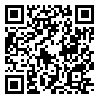Volume 8, Issue 4 (2019)
Naqshejahan 2019, 8(4): 213-221 |
Back to browse issues page
Download citation:
BibTeX | RIS | EndNote | Medlars | ProCite | Reference Manager | RefWorks
Send citation to:



BibTeX | RIS | EndNote | Medlars | ProCite | Reference Manager | RefWorks
Send citation to:
Pahlavan Alamdari L, Habib F, Majedi H, Sattari Sarebangholi H. Investigation and Analysis of Arabesque Patterns and Herbal Designs of Aljaito Altar in Jameh Mosque of Isfahan. Naqshejahan 2019; 8 (4) :213-221
URL: http://bsnt.modares.ac.ir/article-2-31769-en.html
URL: http://bsnt.modares.ac.ir/article-2-31769-en.html
1- Architecture Department, Science & Research Branch, Islamic Azad University, Tehran, Iran
2- Architecture Department, Science & Research Branch, Islamic Azad University, Tehran, Iran , f.habib@srbiau.ac.ir
3- Architecture Department, Tabriz Branch, Islamic Azad University, Tabriz, Iran
2- Architecture Department, Science & Research Branch, Islamic Azad University, Tehran, Iran , f.habib@srbiau.ac.ir
3- Architecture Department, Tabriz Branch, Islamic Azad University, Tabriz, Iran
Abstract: (7076 Views)
Aims Sacred architecture is a reflector of divine beauties, and it is an illustrative example of the combination and association of symbolic forms with our deep beliefs and this connection can be expressed in the deepest mysterious layers of the altar. The altar is the most important part of the religious building. In the history of architectural decorations in Islamic art, altar has always embedded the best and most valuable examples in terms of style and in terms of motifs as well as calligraphy values. The Aljaito altar, in terms of the art of Stucco used in it, is in the rank of the most beautiful works of the Ilkhani era. In this research, the study of the herbal designs of the altar, the characteristics, and generalities of the motifs and the patterns governing them are the aim of the research.
Instruments & Methods Through library and field studies, we have identified the decoration of the altar of the Jameh Mosque of Isfahan. The research method is descriptive-analytical and uses architectural software.
Findings & Conclusion The following results were obtained by examining the designs and decorations of Aljaito altar: 81 patterns of herbal design were extracted from the altar designs, with a range of 28% horizontal rectangle, 22% circle, 21% pentagon, 15% vertical rectangular, 7% star, 6% square, and 1% Shamseh; the majority of it included horizontal rectangle. Also, the dominant line in Aljaito altar designs adhered to 100% of the curve pattern, and 85% were completely non-symmetrical and 15% was vertical to the axis in the herbal designs.
Instruments & Methods Through library and field studies, we have identified the decoration of the altar of the Jameh Mosque of Isfahan. The research method is descriptive-analytical and uses architectural software.
Findings & Conclusion The following results were obtained by examining the designs and decorations of Aljaito altar: 81 patterns of herbal design were extracted from the altar designs, with a range of 28% horizontal rectangle, 22% circle, 21% pentagon, 15% vertical rectangular, 7% star, 6% square, and 1% Shamseh; the majority of it included horizontal rectangle. Also, the dominant line in Aljaito altar designs adhered to 100% of the curve pattern, and 85% were completely non-symmetrical and 15% was vertical to the axis in the herbal designs.
Article Type: Analytic Review |
Subject:
Highperformance Architecture
Received: 2019/04/7 | Accepted: 2019/04/7 | Published: 2019/04/7
Received: 2019/04/7 | Accepted: 2019/04/7 | Published: 2019/04/7
Send email to the article author
| Rights and permissions | |
 |
This work is licensed under a Creative Commons Attribution-NonCommercial 4.0 International License. |








